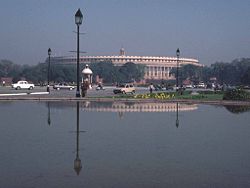| Parliament of India | |
|---|---|
| 15th Lok Sabha | |
 | |
| Type | |
| Type | Bicameral |
| Houses | Rajya Sabha Lok Sabha |
| Leadership | |
| The Chairman of Rajya Sabha | Mohammad Hamid Ansari, (I) since 2007 |
| Majority Leader (Rajya Sabha) | Prime Minister Manmohan Singh, (INC) since 2007 |
| Speaker of Lok Sabha | Meira Kumar, (INC) since 2009 |
| Majority Leader (Lok Sabha) | Pranab Mukherjee, (INC) since 2004 |
| Structure | |
| Members | 802 (250 Rajya Sabha + 552 Lok Sabha) |
| Meeting place | |
 | |
| Sansad Bhavan | |
| Website | |
| Parliament of India Lok Sabha Rajya Sabha | |
The Parliament of India (or Sansad) is the federal and supreme legislative body of India. It consists of the office of President of India and two houses, the lower house, known as the Lok Sabha and the upper house, known as the Rajya Sabha.. It is located in New Delhi at Sansad Bhavan on Sansad Marg. Any bill can become an act only after it is passed by both the houses of the Parliament and assented by the President. The Central Hall of the Parliament is used for combined sittings of the lower and upper houses and is of historical significance.
Etymology
Sansad is the Sanskrit word for House. "Sansad" is NOT the official word used to refer to the Indian Parliament. Indian Parliament is officially known as "Parliament" itself and not "Sansad".
Lok Sabha
LOK SABHA: The Lok Sabha is also known as the "House of the People" or the lower house. Almost all of its members are directly elected by citizens of India. It is the more powerful of the two houses and can precede or overrule the Rajya Sabha (upper house) in certain matters.
The Lok Sabha can have up to 552 members as envisaged in the Constitution of India (Article 81). It has a term of 5 years but it may be dissolved earlier by the President in the event of no confidence motion. Its duration may also be increased during any national emergency. To be eligible for membership of Lok Sabha, a person must be a citizen of India and must be more than 25 years of age. Up to 530 members can be elected from the states, up to 20 members from the Union territories and no more than two members from the Anglo-Indian community can be nominated by the President of India,that is if the president feels that the Anglo-Indian community is not adequacy represented.
As of now,the Lok Sabha has 543 members, 530 members from the states, 13 members from the Union territories and two nominated members representing the Anglo Indian community. Some seats are reserved for representatives of Scheduled Castes and Scheduled Tribes.
The representatives from States and Union territories are directly elected by the people on the basis of universal adult suffrage. Every citizen who is over 18 years of age, irrespective of gender, caste, religion or race, who is otherwise not disqualified, is eligible to vote.
Rajya Sabha
The Rajya Sabha is also known as "Council of States" or the upper house. Its members are indirectly elected by members of legislative bodies of the States.
The Rajya Sabha has 250 members in all. Elections to it are scheduled and the chamber cannot be dissolved. Each member has a term of 6 years and elections are held for one-third of the seats after every 2 years. The composition is specified in Article 80 of the Constitution of India.
- 12 members are nominated by the President from people having special knowledge or experience in literature, science, art or social services.
- Representatives of States are elected by the elected members of the Legislative Assembly of the State in accordance with system of proportional representation by means of single transferable vote.
- Representatives of Union Territories are indirectly elected by members of an electoral college for that territory in accordance with system of proportional representation.
The Council of States is designed to maintain the federal character of the country. The number of members from a state depends on the population of the state (e.g. 31 from Uttar Pradesh and one from Nagaland).
The minimum age for a person to become a member of Rajya Sabha is 30 years
Building
The Parliament House (Sansad Bhavan) is a circular building designed by the British architects Sir Edwin Lutyens and Sir Herbert Baker in 1912–1913. Construction began in 1921, and in 1927 the building was opened as the home of the Council of State, the Central Legislative Assembly and the Chamber of Princes.
The roof of the outer circle of the structure is supported by 144 granite pillars. The Houses are located on Janpath, close to the former Viceroy's House (Rashtrapati Bhavan). It can also be seen from the India Gate.
The former Chamber of Princes was home to the Supreme Court of India until 1958.
The Foundation stone of Parliament House was laid on the 12th February,1921 by H.R.H. The Duke of Connaught. The construction of the building took six years and the opening ceremony was performed on the 18th January,1927 by the then Governor-General of India, Lord Irwin. The cost of construction was Rs 83 lakhs. Size of the Building Parliament House is a massive circular edifice 560 feet (170.69 metres) in diameter. Its circumference is one-third of a mile 536.33 metres and it covers an area of nearly six acres (24281.16 square metres). The open verandah on the first floor is fringed with a colonnade of 144 creamy sandstone columns—each 27 feet (8.23 metres) high. The building has twelve gates among which Gate No. 1 on the Sansad Marg is the main gate. Architectural Design
Apart from the fact that the building was built with indigenous material and by Indian labour, the architecture of the building bears a close imprint of the Indian tradition. The layout of fountains both inside and outside the building, the use of Indian symbols the "Chhajjas" which shade the walls and windows and the varied forms of "Jali" in marble are reminders of the story of the craftsmanship displayed in ancient monuments and memorials. With the ancient features of Indian art are mingled modern scientific achievements in acoustics, air-conditioning, simultaneous Interpretation and Automatic Voting etc.

0 Comments:
Post a Comment